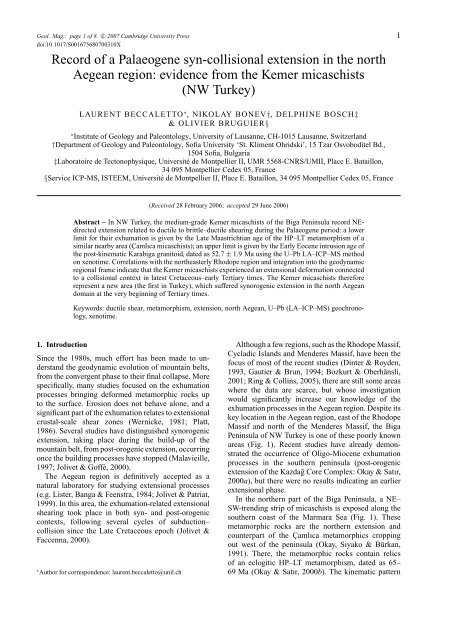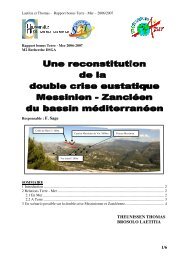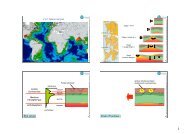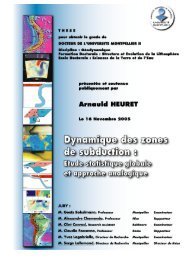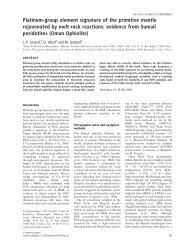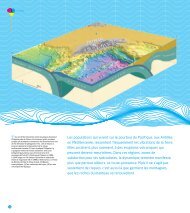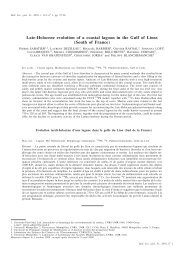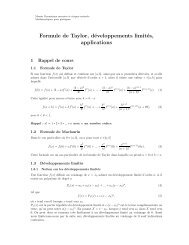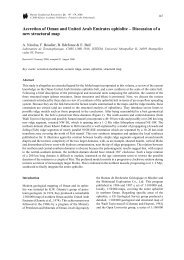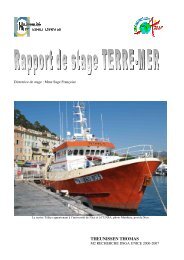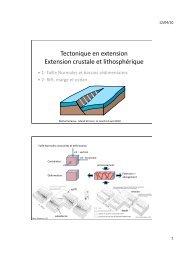Géochronologie U-Pb par ablation laser et ICP-MS (LA-ICP-MS ...
Géochronologie U-Pb par ablation laser et ICP-MS (LA-ICP-MS ...
Géochronologie U-Pb par ablation laser et ICP-MS (LA-ICP-MS ...
Create successful ePaper yourself
Turn your PDF publications into a flip-book with our unique Google optimized e-Paper software.
Geol. Mag.: page 1 of 8. c○ 2007 Cambridge University Press 1<br />
doi:10.1017/S001675680700310X<br />
Record of a Palaeogene syn-collisional extension in the north<br />
Aegean region: evidence from the Kemer micaschists<br />
(NW Turkey)<br />
<strong>LA</strong>URENT BECCALETTO ∗ , NIKO<strong>LA</strong>Y BONEV†, DELPHINE BOSCH‡<br />
& OLIVIER BRUGUIER§<br />
∗ Institute of Geology and Paleontology, University of Lausanne, CH-1015 Lausanne, Switzerland<br />
†De<strong>par</strong>tment of Geology and Paleontology, Sofia University ‘St. Kliment Ohridski’, 15 Tzar Osvoboditel Bd.,<br />
1504 Sofia, Bulgaria<br />
‡Laboratoire de Tectonophysique, Université de Montpellier II, UMR 5568-CNRS/UMII, Place E. Bataillon,<br />
34 095 Montpellier Cedex 05, France<br />
§Service <strong>ICP</strong>-<strong>MS</strong>, ISTEEM, Université de Montpellier II, Place E. Bataillon, 34 095 Montpellier Cedex 05, France<br />
(Received 28 February 2006; accepted 29 June 2006)<br />
Abstract – In NW Turkey, the medium-grade Kemer micaschists of the Biga Peninsula record NEdirected<br />
extension related to ductile to brittle–ductile shearing during the Palaeogene period: a lower<br />
limit for their exhumation is given by the Late Maastrichtian age of the HP–LT m<strong>et</strong>amorphism of a<br />
similar nearby area (Çamlıca micaschists); an upper limit is given by the Early Eocene intrusion age of<br />
the post-kinematic Karabiga granitoid, dated as 52.7 ± 1.9 Ma using the U–<strong>Pb</strong> <strong>LA</strong>–<strong>ICP</strong>–<strong>MS</strong> m<strong>et</strong>hod<br />
on xenotime. Correlations with the northeasterly Rhodope region and integration into the geodynamic<br />
regional frame indicate that the Kemer micaschists experienced an extensional deformation connected<br />
to a collisional context in latest Cr<strong>et</strong>aceous–early Tertiary times. The Kemer micaschists therefore<br />
represent a new area (the first in Turkey), which suffered synorogenic extension in the north Aegean<br />
domain at the very beginning of Tertiary times.<br />
Keywords: ductile shear, m<strong>et</strong>amorphism, extension, north Aegean, U–<strong>Pb</strong> (<strong>LA</strong>–<strong>ICP</strong>–<strong>MS</strong>) geochronology,<br />
xenotime.<br />
1. Introduction<br />
Since the 1980s, much effort has been made to understand<br />
the geodynamic evolution of mountain belts,<br />
from the convergent phase to their final collapse. More<br />
specifically, many studies focused on the exhumation<br />
processes bringing deformed m<strong>et</strong>amorphic rocks up<br />
to the surface. Erosion does not behave alone, and a<br />
significant <strong>par</strong>t of the exhumation relates to extensional<br />
crustal-scale shear zones (Wernicke, 1981; Platt,<br />
1986). Several studies have distinguished synorogenic<br />
extension, taking place during the build-up of the<br />
mountain belt, from post-orogenic extension, occurring<br />
once the building processes have stopped (Malavieille,<br />
1997; Joliv<strong>et</strong> & Goffé, 2000).<br />
The Aegean region is definitively accepted as a<br />
natural laboratory for studying extensional processes<br />
(e.g. Lister, Banga & Feenstra, 1984; Joliv<strong>et</strong> & Patriat,<br />
1999). In this area, the exhumation-related extensional<br />
shearing took place in both syn- and post-orogenic<br />
contexts, following several cycles of subduction–<br />
collision since the Late Cr<strong>et</strong>aceous epoch (Joliv<strong>et</strong> &<br />
Faccenna, 2000).<br />
∗ Author for correspondence: laurent.beccal<strong>et</strong>to@unil.ch<br />
Although a few regions, such as the Rhodope Massif,<br />
Cycladic Islands and Menderes Massif, have been the<br />
focus of most of the recent studies (Dinter & Royden,<br />
1993, Gautier & Brun, 1994; Bozkurt & Oberhänsli,<br />
2001; Ring & Collins, 2005), there are still some areas<br />
where the data are scarce, but whose investigation<br />
would significantly increase our knowledge of the<br />
exhumation processes in the Aegean region. Despite its<br />
key location in the Aegean region, east of the Rhodope<br />
Massif and north of the Menderes Massif, the Biga<br />
Peninsula of NW Turkey is one of these poorly known<br />
areas (Fig. 1). Recent studies have already demonstrated<br />
the occurrence of Oligo-Miocene exhumation<br />
processes in the southern peninsula (post-orogenic<br />
extension of the Kazdağ Core Complex: Okay & Satır,<br />
2000a), but there were no results indicating an earlier<br />
extensional phase.<br />
In the northern <strong>par</strong>t of the Biga Peninsula, a NE–<br />
SW-trending strip of micaschists is exposed along the<br />
southern coast of the Marmara Sea (Fig. 1). These<br />
m<strong>et</strong>amorphic rocks are the northern extension and<br />
counter<strong>par</strong>t of the Çamlıca m<strong>et</strong>amorphics cropping<br />
out west of the peninsula (Okay, Siyako & Bürkan,<br />
1991). There, the m<strong>et</strong>amorphic rocks contain relics<br />
of an eclogitic HP–LT m<strong>et</strong>amorphism, dated as 65–<br />
69 Ma (Okay & Satır, 2000b). The kinematic pattern


